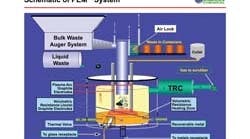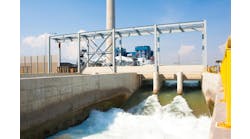Figure 1. Unit teams a high-temperature plasma zone with a glass melting zone.
Source: InEnTec Chemical.
Organic residues that ordinarily would go to incinerators or landfills instead can serve as feedstocks for making synthesis gas via its Plasma Enhanced Melter (PEM) technology, says InEnTec Chemical, Richland, Wash. The company points to positive results from trials concluded in early June in Port Arthur, Texas. A 1-ton/day demonstration unit, hosted by Veolia Environmental Services at its site there, over an eight-week period successfully produced high-quality syngas from 13 different waste streams, ranging from biosolids from wastewater treatment to hexane-rich solutions to materials with high chlorine content, from four nearby plants of major chemical companies.
“As far as we know, no one has previously found a way to extract the chemical or product value out of these materials on a commercial scale,” says Gary Cook, InEnTec Chemical’s CEO.
The PEM teams two heating techniques to crack the residues and form syngas. DC-powered graphite electrodes create a plasma zone that can reach temperatures up to 10,000°C; below this is an AC-heated glass melting zone. This combination provides efficiencies and quality of syngas far in excess of what’s attainable by other plasma technologies, claims InEnTec. Almost 100% of chemical residuals are converted or recycled, says the company, adding that the process complies with all environmental regulations and doesn’t require hazardous waste permitting. The syngas can be conventionally processed to produce hydrogen, methanol, etc.
The gasification technology has been employed for several years by Kawasaki Heavy Industries of Japan to destroy polychlorinated biphenyls and asbestos, and by Global Plasma of Taiwan to produce syngas from medical wastes.
The use of chemical residues as feedstocks to make syngas is a newer thrust, explains Cook. The Port Arthur trials were to show that the technology could handle a variety of residues and produce syngas of suitable quality. Each charge typically consisted of 200 lb. to 300 lb of solids or liquids, with processing lasting for four to six hours.
The first commercial installation is already in the works. Last year, Dow Corning, Midland, Mich., signed a 10-year $50-million contract for a plant to convert about 20 tons/d of hazardous waste into syngas and hydrochloric acid. That facility, which will be operated by Veolia, is expected to start up at the end of the first quarter of 2009. Air Liquide will purchase hydrogen offgas.
InEnTec also foresees a unit with two 20-ton/d trains in the Houston area, adding that construction might begin by the end of this year. Veolia would operate that facility, which would serve a number of chemical plants. In addition, dedicated units at specific sites on the Gulf Coast are a possibility.

